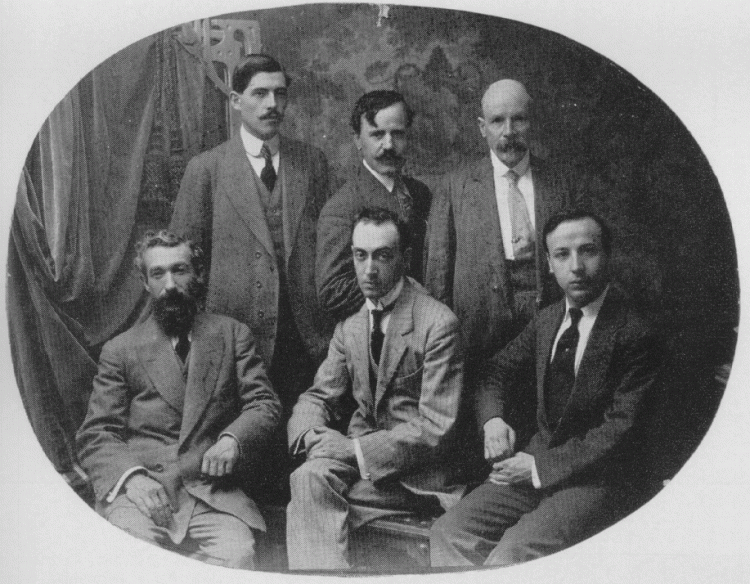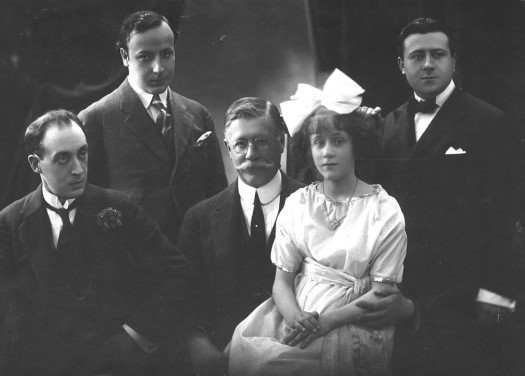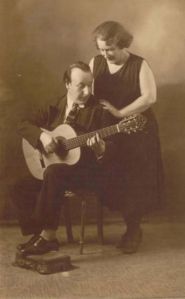Emilio Pujol was transfixed by Francisco Tárrega‘s playing. So much so, he dedicated his life to forwarding, through his books and teaching, the principles of technique he learned from his master. Pascal Roche, in the third volume of his tutor (see Technique) provides an interesting insight into Pujol’s manner of playing: “the brilliant Miguel Llobet, the delicate Pujol”.
The Escuela Razonada de la Guitarra (pub. by Ricordi. English translation of first three volumes by Editions Orphee) is a four-volume treatise. The first volume provides much useful information on the guitar – its physical make up, the thickness of the strings, the use of the turnavoz, the notes and intervals on the fretboard – and the techniques of both hands.
The second volume gets down to playing the instrument, with many exercises for both hands, covering individual movements of the fingers and thumb, the Barre, chords, arpeggios, scales, independence of finger movements, slurs, harmonics, and tuning the 6th string to D. The volume ends with twelve studies and a duet.
The third volume intensifies the study, using the full range of the fretboard. There are thirty nine full studies and many short exercises. The student who works through volumes one to three should have little fear of professional scores.
The fourth volume includes many effects, such as tambora, rasgueado, more advanced use of harmonics and tremolo, trills, etc, etc. The volume ends with over thirty “Estudios Complementarios”.

Standing: Segovia, Llobet. Sitting: Fortea, Pujol.
Regarding the nails, no-nails debate, Pujol wrote one of the most important essays on the subject, entitled “The dilemma of timbre on the guitar“. HERE is a pdf of the English translation of this out of print book.
Pujol starts by attempting a scientific explanation of sound, and comes to the obvious conclusion that a string will sound different depending on what it is struck with, specifically flesh or nail. As the guitarist can’t have both, hence the dilemma.
He then discusses how strings have been plucked by artists in the past, such as vihuela and lute players, but especially the two Spaniards, Sor (flesh) and Aguado (nails).
Finally he gets to his teacher, Tárrega, who had learned initially from Aguado’s method – “He did not realise in those days the possibility of producing a better tone. Once he did realise the superiority of flesh playing, Tárrega withdrew from public concerts for some time… He had to work constantly in order to conquer the difficulties of the new technique in which he was to be master and pupil at once, and when at last these difficulties were overcome, those who heard Tárrega play will never forget the wonderfully pure sound his guitar produced”.
Others, such as Domingo Prat and Isaias Savio, claim that Tárrega suffered badly from a hardening of the arteries, which caused his nails to wither. But whether it was his troubled, searching soul or a medical reason brought him to playing without nails, he seems to have made the most of his discovery, and encouraged his pupils, including Pujol, to cut their nails off.

Sitting ( left to right) : Enrique Garcia ( luthier ) , Miguel Llobet and Emilio Pujol. Standing : Eusebio Gual , Vilatoba de Sabadell (photographer) , Fernando Gausente (founder of the Music Center in Sabadell , Spain).
Pujol goes on to say, “In order to obtain the tone with the fingertips that Tárrega did, it does not suffice to cut one’s nails short; the tone has to be formed: i.e., a certain balance between touch, resiliency and resistance must be developed in the flesh of the fingertips, which can only be acquired by constant practice and care”.
There is much more to the essay, of course, and you are encouraged to read it (see pdf link above). He ends by saying we should be glad we have both ways of playing. His preference is clearly for flesh playing, yet he does not discount nail playing outright. As ever, dear reader, the choice is yours!
Llobet, Pujol, Juan Carlos Anido, Maria Luisa Anido, Domingo Prat.
Here are a few lesser-known compositions by Pujol. The first, Invocacion, is a setting of a Gregorian Chant, Salve Regina, I believe.
The second is a homage to Gustavo Adolfo Becquer, a late 19th-century novelist who influenced the Romantic nationalist movement in art, literature and music. This a beautiful piece:
The third is what I consider to be Pujol’s masterpiece, the “Endecha a la amada ausente“, a lament on the death of his wife, Matilde Cuervas, who died in 1956. Matilde was a singer and guitarist of the flamenco school. They often played duet recitals together, recordings of them can be found on YouTube, and are well worth tracking down. Here they are together in a publicity photo:
The piece starts with a soaring figure, Matilda’s spirit taking flight? Two-thirds of the way through, the music breaks off with a percussive slap followed by a rasgueado, leading into an evocation of a Soleares, “the mother of all flamenco toques”. There are passages of almost ecclesiastical counterpoint to bring calm to proceedings, but emotions overrun Pujol, and the ending is marked “profound et passionnément expressif”. I was a bit shaken for thirty minutes or so after playing it. I’m surprised this is not a more well-known piece.



The pieces of Pujol are an integral part of the history of the guitar and for some performers maligned. I would encourage every guitarist to look into his Method/ School, although tedious, it does teach artistry and open a door to remarkable music.
LikeLiked by 1 person
Good comment, Rod. I agree entirely. There’s a rumour of a fifth volume which never got published…
LikeLike
It’s not a rumour, Pujol himself writes on the Introduction of the four volumes that the complete work comprises a fifth volume resuming his experience on interpretation, transcription, teaching, aesthetic and ethics. There are some evidences that it remained only as working notes and never accomplished a full ready to publish format.
LikeLiked by 1 person
Thanks, Paul. I should say I’ve heard a rumour that all the material for the fifth volume has been located. I can’t name names, but it’s out there.
LikeLike
It is in the. works. Be patient.
LikeLiked by 1 person
The fifth volume deals with how to “study” not to practice. I am told that Pujol never called it practice but study. Technique and the understanding to play slow and even slower when studying is a must! I am told this every Saturday by the master Hector Garcia who studied under Pujol and actually lived with him for a year! He asisted Pujol with master classes and is one few noteable students Pujol spoke of. so my source is reliable.
LikeLiked by 1 person
Cheers, Joel. Have you read my interview with Hector Garcia on this website?
LikeLike
Does anyone know where book four is available ?
LikeLike
Editions Ophee did not translate Volume 4. I asked why, and was told that as it was mostly notated music, with little text. So, you have to buy the original edition, which I believe is still available.
LikeLike
[…] https://rmclassicalguitar.com/pujol/ […]
LikeLike
Hi Rob,
I found out your article dedicated to Manuel Cubedo that is really precious and interesting information about him and his carreer.
Sorry i know it is not really comment about Pujol but he was one of his most famous disciple ! (And i don’t know how to post comment directly on Cubedo’s article…)
Cheers
Matt
LikeLike
Hi Matt. Thanks for that. I’ve now changed the Cubedo page to allow comments. Thanks for pointing that out. Yes, he was an interesting player, sadly unknown to most players today.
LikeLike
According to this post, Hector Garcia has Pujol’s Volume 5 in manuscript format:
https://www.classicalguitardelcamp.com/viewtopic.php?p=740580#p740580
LikeLike
Thanks, Steve. I’m aware of that post, but many won’t be. Hopefully it will emerge soon.
LikeLiked by 1 person
Yes, I’m aware of that. Thanks. I’m a Delcamp member.
LikeLiked by 1 person
See also Emilio Pujol, monografia + CD (Sandro Volta, vihuela/ Mário Carreira, guitar):
http://www.guitartshop.com
LikeLike
dear mister MCKILLOP I am a great admirer of your videos, and I appreciate the delicacy of your playing and the magic of your sound, I discovered on your video the piece Invocation by Emilio Pujol, I did not find any trace of the score on the net, or at any music publisher !!!
Mystery!!!
Didier a French fan
LikeLike
Hi Didier. I found it in a guitar magazine, Guitar Review, from many decades ago. But I have since learned that it has another name, Salve, which is easier to find. It is exactly the same. Cheers, Rob
LikeLike
I found a 701-page doctoral dissertation on Emilio Pujol that was completed in 2010:
Main page: https://www.tesisenred.net/handle/10803/5202
Link to the PDF: https://www.tesisenred.net/bitstream/handle/10803/5202/fehr1de1.pdf?sequence=1&isAllowed=y
LikeLike
I found a 701-page doctoral dissertation on Emilio Pujol from 2010:
Main page: https://www.tesisenred.net/handle/10803/5202
Link to the PDF: https://www.tesisenred.net/bitstream/handle/10803/5202/fehr1de1.pdf?sequence=1&isAllowed=y
(If this was posted twice, please delete one)
LikeLike
Good find, Steven! Thanks for sharing it. That will take some time to sift through.
LikeLike
I was fortunate to be a student at Emilio Pujol’s last master class in 1976. He was 93 years old at the time. I was a student of Hector Garcia at UNM and he encouraged me to go. I was very glad that I did. Pujol was a very humble and gentle soul, a good teacher and had many great stories.
LikeLike
Good to know, Chris. Magical times, I imagine.
LikeLike
Hi Chris, I know this is late but may I ask a little about Pujol in that class in 1976? Is it true that he had hearing problem so he had to use earphones? Is that because of his age or other reason that you happen to know? Thank you in advance.
LikeLike
Wonderful article and wonderful music.
LikeLike
Thanks, Emmanuel!
LikeLike